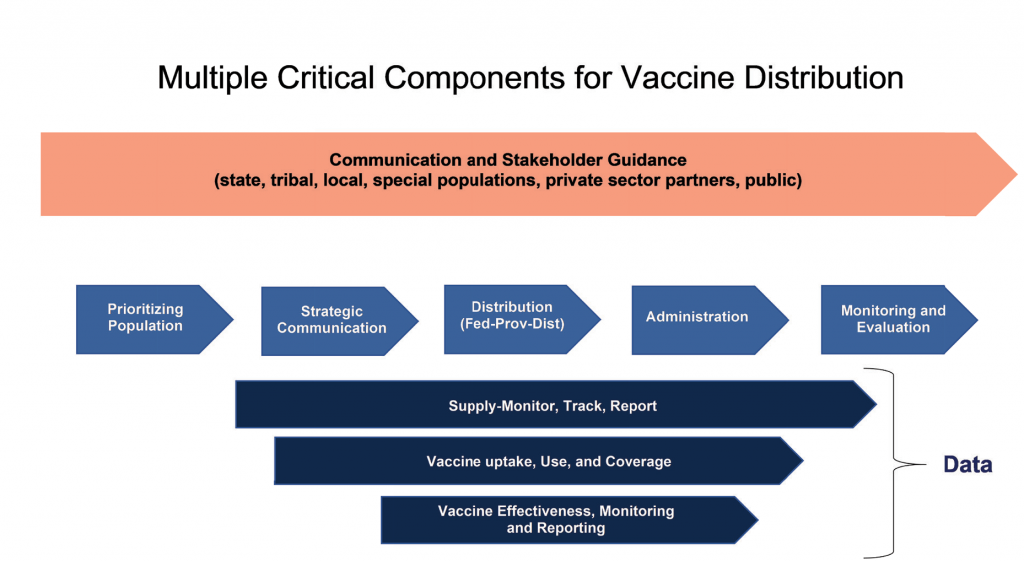Summary
• It is imperative that federal and provincial roles and responsibilities are delineated, and protocols are standardized. Financial resources, logistical arrangements, supplies and administration should be mapped out in keeping with the demarcation of these roles.
• Communication of public health information, advocacy campaigns, and engaging local leaders for social mobilisation are all necessary steps to raise vaccine acceptance and risk perception. A sophisticated communication strategy would address misinformation, dissemination of accurate information and trust
• A robust data regime is vital to track distribution and administration of vaccine stockpiles, vaccine effectiveness and side effects, for inventory, planning, follow-ups and research.
• The distribution should be inclusive and focus on health workers, highest-risk groups and gradually the entire population.• It is vital that existing delivery systems are not overburdened and unable to perform other immunisation responsibilities. For this purpose, capacity enhancement is necessary.
• An analysis of the strengths and limitations of Pakistan’s Polio Eradication Initiative and the Extended Programme for Immunization, suggests that the two should be integrated for an equitable, rapid and cost-effective delivery of the Covid-19 vaccine.
Identifying the Problem
Vaccines are a powerful tool to fight a pandemic in addition to containment and mitigation measures. Pfizer, and Moderna Inc. have created vaccines for Covid-19 that are approved by regulatory authorities to be more than 90% effective [i]. With the pandemic having infected around 76 million people across the globe, many see this as a light at the end of the tunnel [ii]. The World Health Organisation (WHO) has assured Pakistani authorities that they would get around 20 million doses of the vaccine to cover 20% of the population, of which 3% may be available by second quarter, 2021. However, availability of any quantities under COVAX is subject to funding availability at their end. Recently, Prime Minister Imran Khan has given a go-ahead to pre-book a vaccine after which concerned authorities have reached out to several manufacturers [iii].
Vaccine distribution is a vital cog in the entire vaccination program. It is important that a concrete distribution strategy is planned out prior to the procurement of the vaccine in order to ensure that vaccine procurement decisions are made bearing in mind distribution capabilities and limitations. This will reduce the risk of vaccine wastage and mismanagement. A national consensus is necessary to take this process forward successfully; moreover, successful implementation of this program will be dependent on coordination across central, provincial, local governments and between public and private partners. Successful tracking, implementation, management, compliance and data sharing is central to a robust distribution strategy. Moreover, it is essential that a common framework of distribution is applicable to both the private and public sector to ensure quality and effectiveness across the board.
Where is Pakistan in its Covid-19 Distribution Planning?
Developing a vaccine is only the first step; effective deployment of the same could present unforeseen challenges and complexities. Pakistan’s weak healthcare system and persistence of the polio endemic could act as obstacles for a successful vaccine programme.
The government has formed a National Vaccine Taskforce to ensure equitable and reliable access to the Covid-19 vaccine. The Extended Programme for Immunization (EPI) is being considered as the primary delivery mechanism through which deployment will be executed. Moreover, the National Command and Operation Center (NCOC), in collaboration with other stakeholders, has developed the National Immunization Management System (NIMS) to track the immunization program. The proposed distribution mechanism places responsibility on the provincial governments for coordination, timely availability of data, availability of trained manpower, formulation of SOPs for the vaccination process and requisite security plan for the identified facilities to be used as immunization centers. In parallel to this, Sindh government has also recently announced its strategy for immunization whereby it will be following a phased approach by inoculating front-line health workers first, followed by senior citizens and people with underlying conditions, and then moving on to the general public.
Some of the key challenges faced in terms of distribution are as follows:
- Initially approved vaccines internationally require to be stored at ultra-low temperatures for which Pakistan lacks the desired cold chain storage system.
- Most vaccines require two doses and may not be inter-changeable. This means that there will have to be a robust tracking mechanism and supply chain system in place to ensure that there are two shots of the same vaccine available for each person.
- The deployment option under consideration is the Extended Programme for Immunization (EPI) that has its own strengths and limitations. Utilizing resources from this alone puts Pakistan’s routine immunization program at risk given the limited infrastructure, logistical and human resources. The facilities used to provide Covid-19 vaccination will have to continue to deliver their routine care and services, including Covid-19 patients. This places significant burden on the flailing healthcare system.
- A vaccination programme must be supplemented with a containment strategy that ensures that the healthcare system is not overburdened by increasing cases of infections.
- An effective deployment program requires coordination at multiple tiers of government in a real-time environment.
- Public perceptions regarding vaccine are mixed and may impact uptake.
- Significant public resources are required to be invested in the distribution mechanism which may be beyond the $150 million allocated for procurement. Given that the proposed distribution mechanism places certain responsibilities on the provincial governments, clarity is required as to who will be bearing the associated costs.
A Successful Distribution Strategy
To ensure a successful distribution strategy that promises vaccine access for every Pakistani, the federal and provincial governments require a coordinated response that is based on national consensus. Moreover, given the current plan envisaged by the NCOC, close coordination would be required between different layers of government to ensure that timely data is available. In view of this, following are considered critical elements of the distribution strategy.
- Creating a national consensus on the distribution strategy that engages federal and provincial governments.
- Coordination between all stakeholders engaged in vaccine policy before and after the distribution process and ensuring clarity of roles, including where the financial burden is placed along the value chain.
- Monitoring data from the vaccination program through a data regime capable of supporting and tracking distribution, administration, and other data.
- Communicating public health information to the public before and after the distribution to promote public risk perception and vaccine confidence.

Recommendations
1
Distribution Mechanism and Implementation
The federal government should distribute the vaccine to provincial governments based on a uniform criteria that covers demographics, number of cases, and hospital capacity e.g. number of ventilators, hospital beds, staff. Each district should have a ‘micro plan’ or a district risk categorisation scheme, whereby ‘high’, ‘vulnerable’, ‘low’ levels of threat should be identified. This should be done according to the number of active cases, severity of the cases, as well as recurrence and reseeding of the virus. Effective risk management would entail that vaccines should be instantly allocated to these areas. This is to ensure that frontline efforts are focused for maximum impact. Centralised distribution and robust communication mechanisms would ensure that the government has full control and supervision of the vaccine program, and coordinates with provincial governments to ensure effective delivery.
In the first phase, vaccines should be transferred to administration sites and vaccine delivery service points like fixed vaccine centers (EPI), pharmacies, hospitals, emergency centres, and public health clinics by provincial and district authorities. The government’s plans to limit vaccine distribution to federal, provincial and district health facilities would push socially and economically vulnerable people, and those with limited mobility, through the cracks. Dormant adult vaccination centres in hospitals should be made operational to ensure that efforts focused towards child immunisation aren’t entirely redirected to Covid-19 vaccine distribution; the Covid-19 vaccination program should not set the country back in terms of polio vaccination or the general immunization program.
In the second phase, once stockpiles increase, community based mobile vaccination teams should be mobilised for the vaccination program. Transitory health facilities, mobile vaccination clinics, vaccination desks, or door-to-door vaccines are all viable options for ensuring easy access to the vaccine, especially for hard to reach populations and those with mobility issues like women and the elderly. Local teams under the PEI, EPI and Lady Health Workers (LHWs) should be deployed for the Covid-19 response. Moreover, an Emergency Response Unit should be engaged at the district and sub-district level for rapid provision of vaccine for life threatening cases. Capacity building measures should take place whereby additional staff is trained by PEI and EPI, and added to the workforce. This is to ensure that all resources aren’t invested in the Covid-19 initiative while neglecting other healthcare responsibilities.
It is imperative that federal and provincial roles and responsibilities are delineated, and there’s uniformity in protocols. Financial resources, logistical arrangements, supplies and administration should be mapped out in keeping with the demarcation of these roles. The proposed NIMS places certain asks on the provincial governments which include:
- Dedicated multi-tiered organization built around existing Health & EPI structure for vaccine administration.
- Timely availability of requisite data to the center.
- Designated health facilities for vaccine administration.
- Close coordination between EPI and Health Ministries down to District and Tehsil level and below for supply chain management and vaccine administration.
- Availability of trained manpower and infrastructure.
- Formulation of SOPs for vaccination process.
Certain aspects of the same such as SOPs for vaccination process and training packages for healthcare workers could be standardized to eliminate duplication of resources. Moreover, clarity is required as to who will bear the associated costs of the above.
2
Strategic Communication and Public Engagement
Consistent and accurate information should be the foundation of the communications effort. This information should be communicated through news, print, and social media, as well as schools, mosques and community centres. Communication campaigns should be launched to address health illiteracy, overcome behavioural barriers and cultivate trust. Public officials should ensure they do not add to vaccine mistrust and anxiety by sharing conflicting reports, information and messages. Moreover, post-marketing surveillance is also vital to identify adverse events and keep track of outcomes in relation to the vaccine drive.
Local community leaders should be engaged to promote vaccine confidence, countering misinformation, and for reaching out to hard to reach populations. Celebrities and influencers should be engaged as advocates in this programme to bust myths around vaccine safety and efficacy, as well as for highlighting its importance.
3
Monitoring and Evaluation
Once vaccinated, a registration process should take place to identify recipients of the vaccine and to tag areas where maximum inoculation has taken place. This registration process is essential for vaccine passporting, and to ensure that consequent doses are administered effectively. Moreover, a robust data regime would ensure that data is granular, side effects are recorded in follow-up sessions, and inventory is accounted for for tracking, monitoring and administration purposes. The government’s plan of initiating an e-monitoring and registration system for vaccine requests, appointments, and recording vaccine doses between visits must be reconsidered due to issues of digital connectivity and limited penetration of technology.
Communication and coordination is essential to making vaccine efforts a success. There should be routine communication and coordination between the Ministry of Health, WHO, NCOC, PEP, EPI, the National Vaccine Taskforce, and federal and provincial stakeholders. All communications, data and updates should be recorded in a unified system to ensure that information and data is readily available to assist with decisions on vaccine distribution, monitoring, as well as procurement for consequent phases of distribution. This data should include numbers provided by both the private and public sector.
Digital systems should capture required data for various aspects of the vaccination program. This data should also be used for geotagging and identifying targeted areas and mapping out areas that have been covered. Contact tracing and surveillance should be maintained throughout the different phases of vaccine distribution. Data should be disaggregated to reveal patterns that can be used for more informed national decision making in the future, such as additional vaccine purchases. Data sharing is critical for monitoring the vaccine’s long term efficacy and safety.
Bi-monthly reviews at district and provincial levels for the Covid-19 vaccination program should take place. These reviews should take place on a national, provincial, divisional and district level, and should be consolidated and integrated into a central structure. This data should be available to be used for decision making. Any gap in training, staff, vaccine inventory should be covered according to the data recorded. It is essential that communication mechanisms are established between Union Council Officers, Assistant Commissioners, and District Health Officers to assess the scope of the vaccine efforts, delivery, and also report on the supply and demand of stockpiles.
This material has been developed by Tabadlab in partnership with DRI. It has been funded by UK aid from the UK government; however, the views expressed do not necessarily reflect the UK government’s official policies.
End Notes
[i] Johnson, C & Steckelberg A. (2020, December 16). Your Questions about the Coronavirus Vaccine, Answered. The Washington Post. Retrieved from: https://www.washingtonpost.com/health/2020/11/17/covid-vaccines-what-you-need-toknow/?arc404=true
[ii] 2IANS. (2020, December 15). Global Covid-19 Cases Exceed 72.8 Million: Johns Hopkins University. The Business Standard. Retrieved from:
https://www.business-standard.com/article/current-affairs/global-covid-19-cases-exceed-72-8-million-johns-hopkins-university-120121500138_1.html
[iii] Web Desk. (2020, November 17). PM Imran Khan Green-Lights Pre-Booking of Coronavirus Vaccine. The News. Retrieved from:
https://www.thenews.com.pk/latest/745060-pm-imran-khan-directs-authorities-to-pre-book-coronavirus-vaccine







